
For the first time, the 2020-2025 Dietary Guidelines for Americans (DGAs) provide recommendations for infants and toddlers from birth through 24 months. The inclusion of these new recommendations in the DGAs underscores the importance of examining the diet quality of young children, particularly those served by the U.S. Department of Agriculture’s Food and Nutrition Service (FNS) Child and Adult Care Food Program (CACFP), which provides meals and snacks to more than 4.2 million children each day using guidance that is based on the DGAs.
The CACFP nutrition standards (also known as “meal patterns”) address children up to age 18; however, the National School Lunch Program plays an important role in providing nutrition supplementation to school-age children, whereas CACFP may be the primary source of nutritional supplementation for preschool-aged children. Thus, here we focus on children aged 5 and younger in the childcare center setting. This includes children served by the more than 65,000 childcare centers who are participating in CACFP. Furthermore, President Biden’s American Families Plan proposes to provide universal preschool to all 3- and 4-year-olds, which could greatly increase the number of children served by CACFP. Children attending full-time childcare programs are typically served breakfast, lunch, and a snack, which constitutes a recommended 2/3 of their total daily nutritional intake. As such, the CACFP nutrition standards have the potential to significantly impact diet quality of children across the U.S.
CACFP meal patterns were updated in 2016 to better align with the 2015-2020 DGAs. While the DGAs and CACFP meal patterns are based on common science, the inclusion of new guidelines for young children in the 2020-2025 DGAs presents an opportunity to assess alignment between the current DGAs and CACFP nutrition standards.
CACFP vs. 2020-2025 DGAs for Children 0 to 11 Months Old
Both the CACFP meal patterns and the DGAs encourage exclusively feeding of human milk to infants 0 to 5 months old, if possible. Otherwise, they recommend formula and not introducing complimentary foods until 6 months of age. CACFP provides recommended serving sizes for milk/formula for infants, while the DGAs do not.
For children 6 to 11 months old, CACFP meal patterns and the DGAs align in terms of timing and type of complementary foods to be offered starting at 6 months. However, as with infants, CACFP provides recommended serving sizes for 6- to 11-month-old children, while the DGAs do not. Instead, the DGAs state, “Although the Dietary Guidelines does not provide a recommended dietary pattern for infants ages 6 through 11 months, infants should be on the path to a healthy dietary pattern that is recommended for those ages 12 through 23 months.”
CACFP vs. 2020-2025 DGAs for Children 1 to 5 Years Old
While DGA guidelines, including recommended serving sizes, for children 12 to 24 months old (1- to 2-year-olds) are new, the CACFP meal patterns and the DGAs for children aged 1 to 5 are already mostly in alignment. However, because of flexibility in CACFP meal patterns, it is possible that childcare centers following meal pattern guidance could provide less or more than the DGA’s recommended servings for most food groups. Table 1 shows a comparison of CACFP meal pattern guidelines to DGA guidelines for children receiving breakfast, lunch, and snack at a childcare center. Ranges reflect options in the meal patterns (e.g., protein may be served instead of grains at breakfast up to 3x/week; 2 out of 5 components are chosen for snack) and are based on Academy of Nutrition and Dietetics guidance that full-day childcare centers should provide about 2/3 of a child’s daily nutrition.
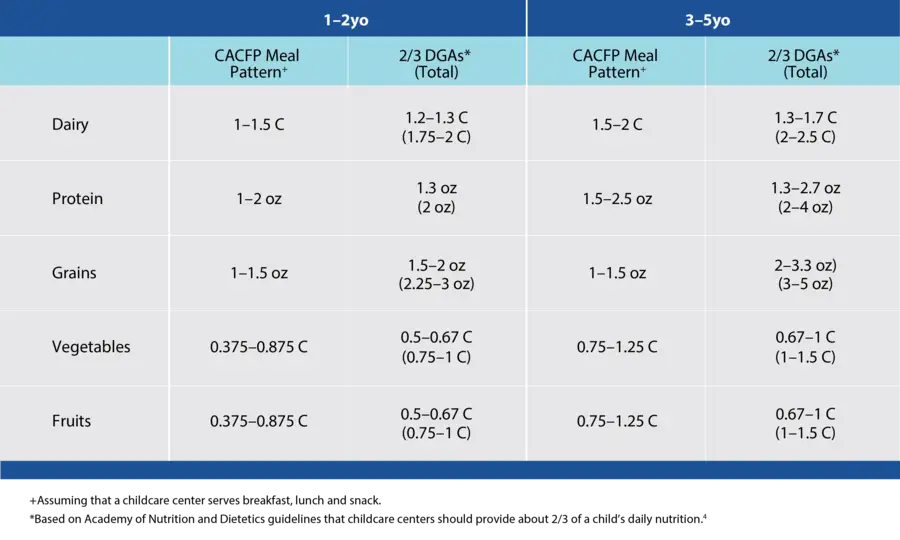
Dairy
Per CACFP guidance, “Childcare centers are required to serve milk at all meals as a beverage and may choose to serve milk as one component of a snack when the other component is not juice.” Unflavored whole milk is served to 1-year-olds, and unflavored low-fat or fat-free milk is served to children ages 2 to 5. To meet DGA guidelines, 1- to 2-year-olds in a full-time childcare program should receive 1.2 - 1.3 cups of dairy or dairy substitute during the school day, and 3- to 5-year-olds should receive 1.3 - 1.7 cups. If CACFP centers serve the minimum amount of dairy in this range, children might receive slightly less than the amount of dairy recommended to be served during the school day. However, because most single-serve containers of milk come in 1 cup (8 oz) portions, children who are being offered milk with breakfast and lunch in CACFP childcare centers are likely being served at least 2 cups of milk per day. This means that children, especially 1- to 2-year-olds, could actually exceed the recommended total daily servings of dairy if they consume all the milk served to them at their childcare center and also consume dairy at home.
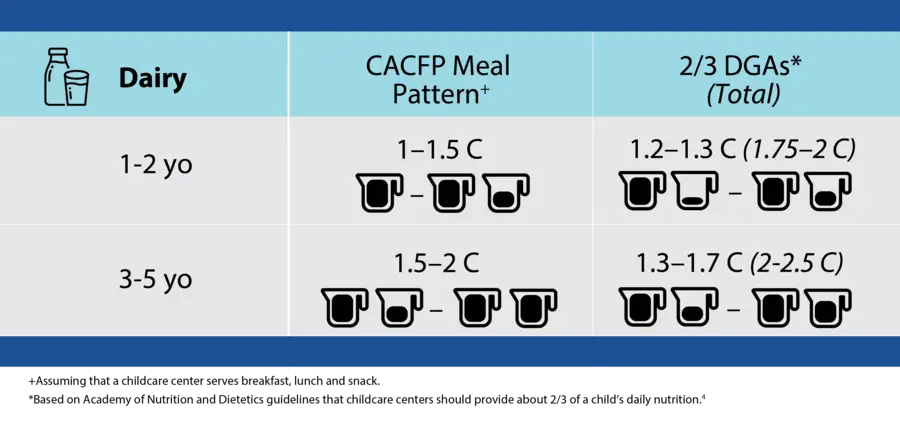
Protein
According to CACFP guidelines, childcare centers are required to serve a meat or meat alternate at lunch and may choose to serve a meat or meat alternate at breakfast and/or snack. For 1- to 2-year-olds, this amounts to 1 - 2 ounces of meat. The DGAs recommend 2 ounces of protein for the entire day for this age group; therefore, depending on how much protein is served at home, 1- to 2-year-olds could consume more than the daily recommended amount of protein. Per CACFP guidelines, 3- to 5-year-olds receive 1.5 - 2.5 ounces of protein a day, which aligns with DGA recommendations.
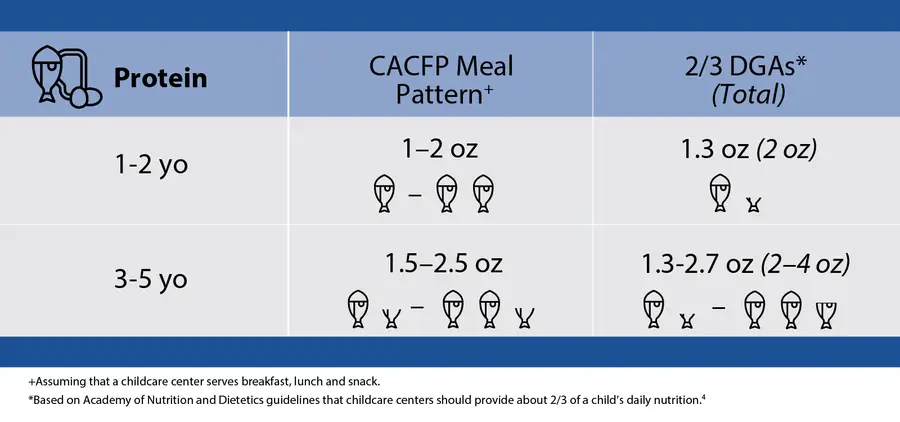
Grains
For grains, CACFP meal pattern guidelines are the same for ages 1 to 5 years: they instruct the provision of a minimum of 0.5 ounces of grains at breakfast and lunch, and the option of 0.5 ounces of grains as a snack component. At least one serving of grains per day must be whole-grain rich. Per these guidelines, 1- to 5-year-olds may receive a minimum of 1 ounce of grains in a CACFP childcare center on a given day, 0.5 ounces of which should be whole-grain rich. This is less than the minimum that should be served in a childcare setting in order to meet DGA recommendations and leaves 1.25 - 2 ounces of grains to be served at home per day for 1- to 2-year-olds and 2 - 4 ounces per day for 3- to 5-year-olds, depending on the size and calorie needs of the child. In addition, for all age groups, if only 0.5 ounces of whole grain is served by a childcare center, the majority of grains served at home must be whole-grain rich for a child to meet DGA recommendations.
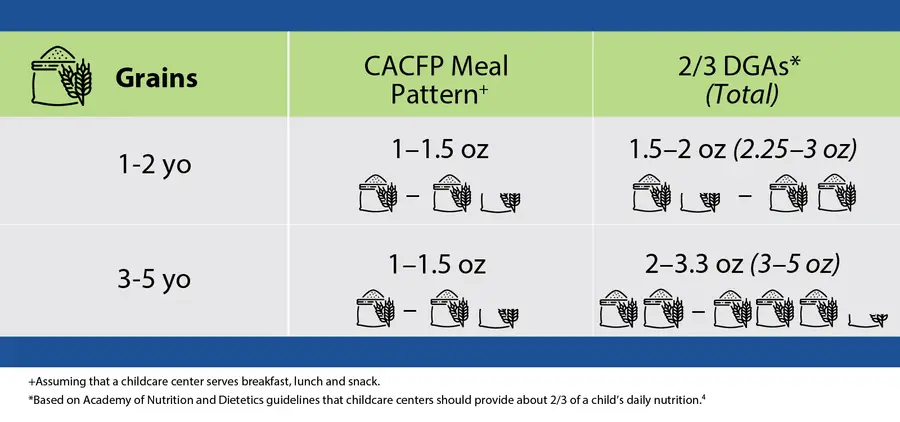
Fruits and Vegetables
According to the CACFP handbook, childcare centers are required to serve a vegetable and/or fruit with breakfast and may choose to serve a vegetable or fruit as one component of snack. One serving each of fruit and vegetable are required for lunches. Per the meal patterns, 1- to 2-year-olds receive 0.375 - 0.875 cups each of fruit and vegetables daily. The minimum of this range is less than what is recommended to align with the DGAs, while the maximum is more than what is recommended. For 3- to 5-year-olds, meal patterns call for 0.75 - 1.25 cups each of fruits and vegetables per day. The maximum end of this range is more than what is recommended to align with DGAs and approaches the total daily recommended amount for fruits and vegetables (separately).
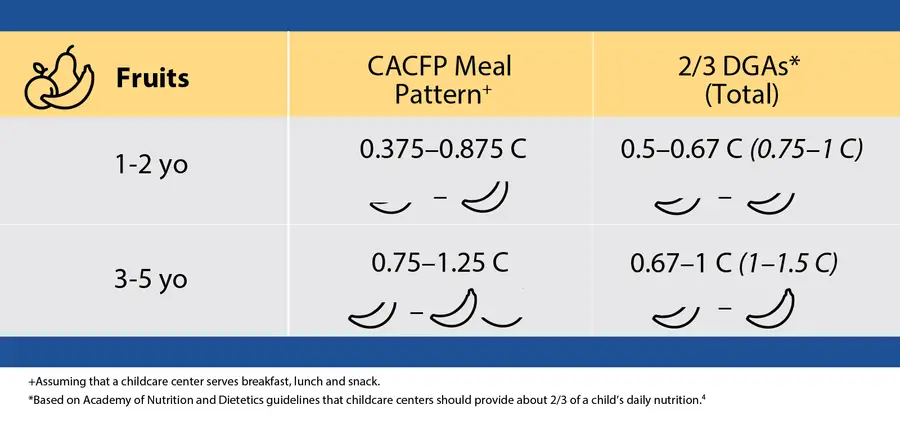
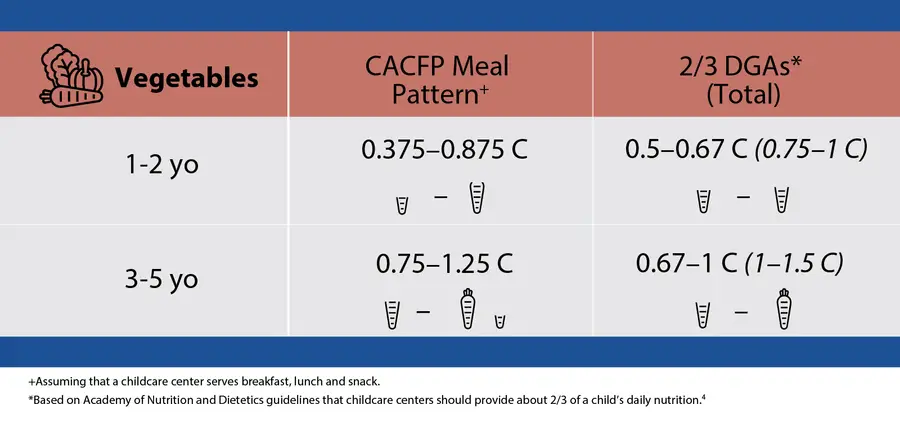
Challenges of Improving Alignment between CACFP Meal Patterns and DGA Guidelines
Table 1 shows that although CACFP meal patterns and DGAs generally align, the allowable ranges in serving sizes in current CACFP standards sometimes leave room for falling short of, or exceeding, the amounts recommended to be served in a full-time childcare setting in order to meet DGA guidelines. Although research has shown that participation in CACFP may have a positive impact on children’s food environment and nutritional intake, outcomes may be improved by revising meal patterns to more directly align with the 2020-2025 DGAs.
However, such changes to CACFP meal patterns may not make a difference without provision of support to help childcare centers meet the standards for what is served, and how. Despite many CACFP childcare centers reporting that they were “very familiar” with the updated standards, studies have reported mixed success in centers’ adherence to the meal patterns. One study found that nearly 90% of centers examined met meal pattern requirements, while another found that the fruit and vegetable CACFP requirements were only partially met, and certain grain and meat/meat alternate requirements were not met at all (e.g., regular beef and full fat cheese products were commonly served). Another study found that while childcare centers provided access to all required lunch components, not all components were placed on the child’s plate; vegetables were less likely to be served than meat or grains. Additionally, for the centers examined in the study, servings of meat and grains were high and milk was low compared with CACFP recommended portion sizes. These studies underscore a need to understand barriers to meeting current CACFP standards before the standards are further modified.
The Quandary of Ensuring Adequate Nutrition in Preschoolers
Ensuring actual intake of nutritious foods can be a challenge even when CACFP childcare centers are serving the recommended amounts from each food group. For example, one study found that the mean intake for grains, fruits, and vegetables for children aged 3 to 5 years in CACFP childcare centers was significantly lower than DGA recommendations even though childcare centers were meeting the updated CACFP requirements regarding foods served. Notably, 25% of children in the study did not consume any vegetables during their meal. Another study found that while intake indicators were more favorable among children in CACFP childcare centers compared to non-CACFP childcare centers, caloric and dietary fiber intake were below recommendations in both groups. This calls into question whether young children are consuming enough servings of grains, fruits, and vegetables outside of childcare to meet daily intake recommendations. At least one study found that they are not, reporting that preschool-aged children consume more calories and less fruits, vegetables, and milk outside of childcare centers than recommended. One implication of these findings is that the possible provision of more than 2/3 of the daily recommended amount of fruit, vegetables, and dairy in childcare settings may not be cause for concern since children may not be consuming the recommended amount of these foods at home.
The DGAs emphasize that nutrients consumed during the time from birth until a child’s second birthday are critically important for brain development and growth. Because this age group consumes such small amounts of food, every bite counts. The DGAs also point out that, while grains may be overconsumed due to the contribution of refined grains, even the youngest children are consuming less than the recommended amount of whole grains. Because children may not be meeting dietary guidelines while in CACFP childcare centers, the implication is that they may not be getting adequate nutrition more broadly.
RTI researchers, in collaboration with partners at Duke University, the University of North Carolina at Chapel Hill, and the University of Minnesota, have a manuscript in press that describes development and application of a dietary quality index for 12-23.9 month-olds based primarily on the new DGAs and recommendations of other leading groups. RTI expert Dr. Andrea Anater explained, “At least with the super young children, what we found in developing our index is that it is very challenging for the youngest children to consume anything outside of recommended foods if they are to meet their DGA requirements. They cannot consume any discretionary calories. This may make it hard for CACFP childcare centers to meet requirements.”
Where to Go from Here
The nutrition of infants and children has been a federally supported priority since the inception of CACFP, and now the DGAs have expanded their guidance to include even the youngest children. Given the challenges of ensuring adequate nutrition for young children, research and funding are needed to optimize the implementation of national nutrition standards in childcare centers.
Specifically, research is needed to understand how systematically CACFP meal pattern guidelines are being met and what barriers childcare centers face in meeting guidelines. Understanding the barriers that centers are facing in serving the recommended amounts and types of food to children may aid FNS in identifying ways that childcare centers can be better supported in meeting guidelines.
Additionally, research and support are needed to improve children’s intake of nutrient-dense foods served in CACFP childcare centers. FNS could consider supporting childcare centers in pursuing evidence-based practices that have been shown to increase children’s consumption of fruits, vegetables, and other nutrient-dense foods, such as engaging young children in gardening and/or preparing foods. Regardless, the addition of the recommendations for infants and toddler from birth to 24 months in the 2020-2025 DGAs is a solid first step in providing a framework that CACFP can use to prioritize next steps.


